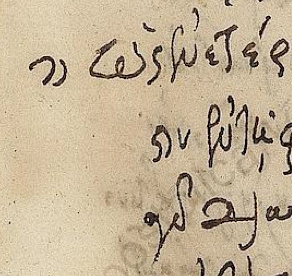 You’ve probably seen it in word-processed text, that funny backwards-P sometimes visible at the beginnings of paragraphs. It’s an ancient symbol that originated in the days when words were often broken across lines without a hyphen and sometimes run together without spaces so that it could be difficult to tell where one thought ended and another began.
You’ve probably seen it in word-processed text, that funny backwards-P sometimes visible at the beginnings of paragraphs. It’s an ancient symbol that originated in the days when words were often broken across lines without a hyphen and sometimes run together without spaces so that it could be difficult to tell where one thought ended and another began.
The concept of the pilcrow is related to the Greek word paragraphos, the origin of our word “paragraph” from para (beside, next to, apart from) and grapho (write) but no one has given a really satisfying etymology for the word pilcrow. It has been suggested that pargrafte or pylcrafte somehow mutated into pilcrow but that seemed a bit of an aural stretch, so I looked up pilcrow in dictionaries from 1700 and earlier.
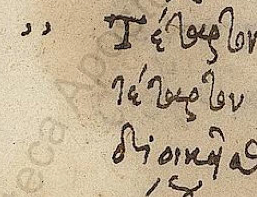 Looking at many definitions gave me the feeling pilcrow may have existed alongside the Greek-Latin paragraphus because old dictionaries listed it next to paragraphus as though they were synonyms, rather than as one leading to the other. In A Dictionarie of the French and English Tongues (1611), it is spelled Pill-crow which suggests it might have evolved from two words combined.
Looking at many definitions gave me the feeling pilcrow may have existed alongside the Greek-Latin paragraphus because old dictionaries listed it next to paragraphus as though they were synonyms, rather than as one leading to the other. In A Dictionarie of the French and English Tongues (1611), it is spelled Pill-crow which suggests it might have evolved from two words combined.
I tried looking up pill-crow, pylcrow and pull-crow and then remembered that many older languages would not have added “w” to the end. It then occurred to me that the Spanish pvlcro/pulcro, which means neat or tidy, might be related. I haven’t seen anyone propose pvlcro as a possible forerunner for pilcrow, but sound-wise it’s more tenable than pargrafte or even pylcrafte and the idea of tidying up or summing up a neat group of text might fit the sense of it, as well. So, it’s possible that there is a forerunner to pilcrow (perhaps pulcro or two words combined, or something else) that is not directly descended from paragraphos.
Whatever the origin of the name, the symbol was used to mark a new section, just as it is now.
The Pliable Pilcrow
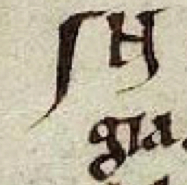 The symbol has a very interesting visual history. Sometimes it was little more than a horizontal slash, or a vertical one, as in this Latin text on the right, from around 1100, or as in the example shown above with double slashes.
The symbol has a very interesting visual history. Sometimes it was little more than a horizontal slash, or a vertical one, as in this Latin text on the right, from around 1100, or as in the example shown above with double slashes.
 Sometimes a loop was added to the slash, making it look more like a contemporary pilcrow. That’s not to say every pilcrow was roughly P-shaped. Many didn’t resemble this shape at all.
Sometimes a loop was added to the slash, making it look more like a contemporary pilcrow. That’s not to say every pilcrow was roughly P-shaped. Many didn’t resemble this shape at all.
If we look at medieval documents, there is a symbol called the “capitulum” (the diminutive of the word kaput for “head”). The capitulum or little-kaput is a C-shape that was used more liberally than our current concept of chapter or paragraph. It could mark a page, a paragraph, or even a sentence, and would sometimes occur mid-text, as well as at the beginning of the line.
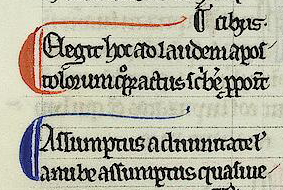 In documents with only one color ink, sometimes the capitulum was drawn larger, to distinguish it from the letter C. To further distinguish it from the rest of the text, sometimes that extra vertical slash on the right, used to embellish the character, was extended below the line and superficially resembled the backwards-P.
In documents with only one color ink, sometimes the capitulum was drawn larger, to distinguish it from the letter C. To further distinguish it from the rest of the text, sometimes that extra vertical slash on the right, used to embellish the character, was extended below the line and superficially resembled the backwards-P.
When colored pigments were available, it was commonly drawn in red and sometimes blue. Alternating the blue and red made it easier to find certain passages and eventually scribes figured out that the colors could have meaning.
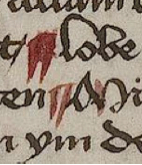 In one old ecclesiastical manuscript, there is a legend in the margin that designates blue and red capitula as 1) noteworthy, or 2) as biblical miracles. When used in this way, a capitulum can function as a combination paragraph marker and manicule.
In one old ecclesiastical manuscript, there is a legend in the margin that designates blue and red capitula as 1) noteworthy, or 2) as biblical miracles. When used in this way, a capitulum can function as a combination paragraph marker and manicule.
The simple double-slash capitulum was still in use in the 15th century and is shown in its more basic form to the right. Sometimes a stem was added across the top, which makes it look more like an F than a double -slash or a C.
Variations on a Theme
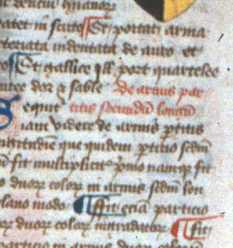 Many of the section markers in the document to the right are drawn with the simple double-slash with an upper stem, but the two at the bottom look more like the letter C except that the bottom stem has a gap. The thicker back to the slash-shape that makes it resemble a C suggests greater emphasis.
Many of the section markers in the document to the right are drawn with the simple double-slash with an upper stem, but the two at the bottom look more like the letter C except that the bottom stem has a gap. The thicker back to the slash-shape that makes it resemble a C suggests greater emphasis.
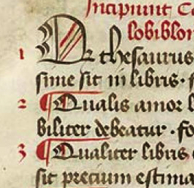 Sometimes the shape is in between a backwards-P and a C as in the text to the left. These examples illustrate that scribes weren’t specifically trying to make these symbols look like Pees and Cees and were more concerned with their function than their exact form. When they are larger than the other letters and colored, there’s no problem recognizing their intended purpose.
Sometimes the shape is in between a backwards-P and a C as in the text to the left. These examples illustrate that scribes weren’t specifically trying to make these symbols look like Pees and Cees and were more concerned with their function than their exact form. When they are larger than the other letters and colored, there’s no problem recognizing their intended purpose.
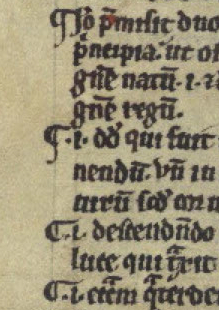 Why did old manuscripts use these shapes instead of extra blank lines or indents?
Why did old manuscripts use these shapes instead of extra blank lines or indents?
Because parchment was expensive. It’s very labor intensive to kill a goat or calf, strip its hide, scrape off the hairs, and then prepare the parchment or vellum so it’s thin enough and smooth enough to use as a writing surface. Cramming the words together and using capitula for the breaks allowed more words to fit on the page.
End Markers
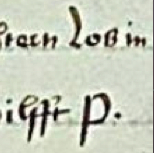 Sometimes a paragraph marker is put at the end, instead of the beginning of a paragraph, similar to the way Fin (end, finished) is used at the end of a story. Most of the time, in old documents, a pilcrow or capitulum symbol is used, but a simple P can also suffice (right).
Sometimes a paragraph marker is put at the end, instead of the beginning of a paragraph, similar to the way Fin (end, finished) is used at the end of a story. Most of the time, in old documents, a pilcrow or capitulum symbol is used, but a simple P can also suffice (right).
Languages will sometimes borrow shapes from each other but assign them different values. The “-ris” abbreviation often used in old Latin texts shows up as an end-paragraph marker in German texts.
What does the pilcrow have to do with the Voynich Manuscript? It was too long for one blog, so I continue the topic here.
J.K. Petersen
© Copyright 2016 J.K. Petersen, All Rights Reserved
Postscript 13 May 2020: I have continued to study the enigmatic glyphs that head up each paragraph in the VMS and I am more convinced than ever that they have a pilcrow-like function rather than a letter-like function. In other words, in the VMS, the first glyph in each paragraph is not part of a word, it is a marker-glyph.
I have posted more than one blog on pilcrows and have already published some statistics for how the beginning-glyphs behave, plus I have run more tests since then. These include statistics on the makeup of the beginning-paragraph tokens with and without the first glyph.
This marker-like function is not limited to the VMS. It also occurs in medieval manuscripts, as in the example below.
In the Wellcome Apocalypse (MS49), the two letter-shapes to the left of each paragraph-group more-or-less alternate throughout the manuscript in essentially the same way as the begin-paragraph gallows glyphs in the Voynich Manuscript. They guide the eye to major sections.
But at the same time, there are also capital letters for the beginnings of words and major sections, a pattern that is also characteristic of the VMS. In other words, in MS49, the same letter-shape can serve a marker function and a letter function, something that may also be true for the VMS: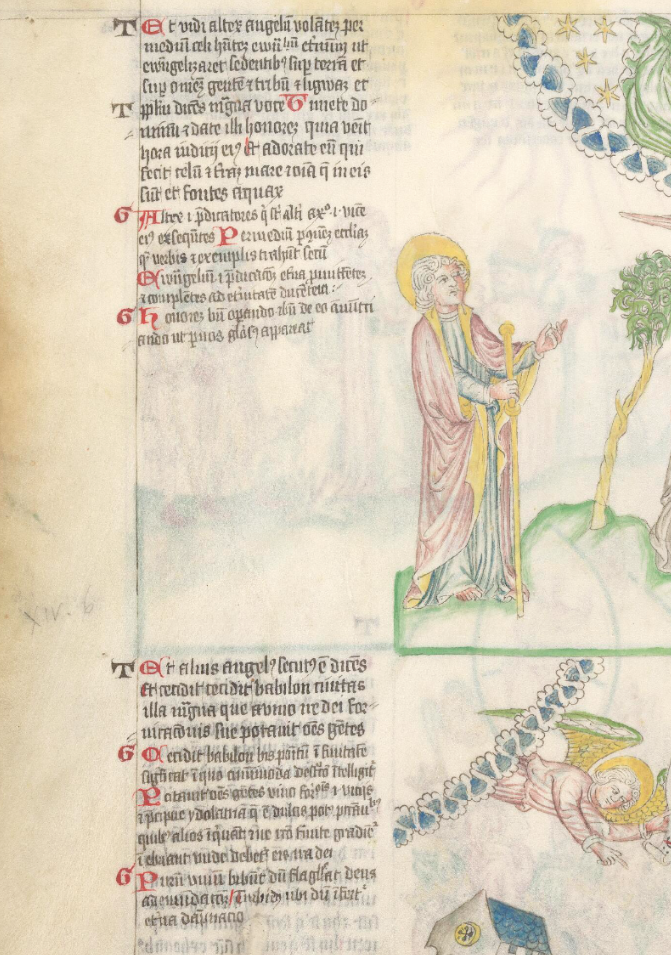
With thanks to Arca Librarian, who alerted us that the Wellcome Apocalypse (MS49) is now available for viewing online.

